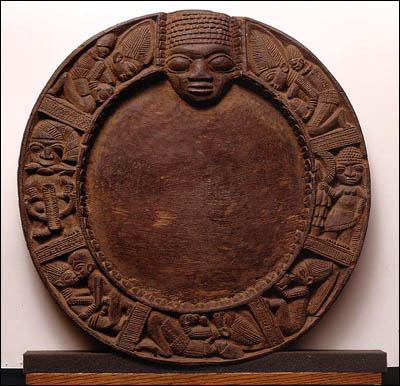




Face of the Gods: Art and Altars of Africa and the African Americas
Thompson, Robert Farris
The Museum for African Art, New York / Munich : Prestel, 1993.
Livro em ótimo estado de conservação, ilustrado , formato grande, uma preciosidade para todo que se dedica seriamente ao estudo da religião dos Orixás bem como das diferentes nações africanas, não perca, saiba mais...
Um completo, substancioso e ilustradíssimo tratado sobre o importante elemento do culto de origem africana, o altar.
Suas origens e seu uso em Cuba, na santeria, no Brasil, no Vodu, no Norte América, e em diversos ritos africanos do continente.
Com mapas, desenhos e muitas fotografias em alta definição tudo sobre o bom funcionamento ordenado do culto aos orixás, voduns e demais entidades dos ritos africanos....
Prefacio de K Kia Bunseki Fu-Kiau. / Susan Vogel.
O conceito de altar, arvores, pedras, sangue e fogo, o lugar crença, o lugar da transformação, bibliografia extensa, a face do passado, a infinidade Iorubás, notas, etc.... saiba mais....
1993, illustrated edition, Extensive photographs; maps, notes and index. Text ed.: David Frankel. 336 pages with 282 full color and 27 black and white illustrations.
Highly recommended for any Orisa devotee, a follower of African traditional religions, or anyone interested in the African diaspora. It would be a great gift More...
even to the illiterate, as the photographs are amazing.
Thompson, professor & head of the department of African Art at Yale, directed this incredible exhibition in 1993 at NYC's Museum of African Art.From Ifa in Nigeria, to Santeria in Puerto Rico, to Obeah in Jamaica, to Vodun in Haiti, he and his companion scholars and curators have contributed in a healing circle across the Middle Passage.
The book opens with the fire altars of the foraging Mbuti, of the Ituri Forest in northeastern Zaire, and of the San, of Namibia.
Next it describes minkisi, the extraordinary medicines of God still made in Kongo and the Kongo-influenced civilizations of Central Africa.
The minkisi tradition, Thompson shows, traveled intact across the Atlantic.
In Havana as in the Bronx, it expands in altars to Afro-Cuban deities such as Sarabanda, its complex symbolic constructions sometimes artfully contained in as small and secret a place as an apartment closet.
Likewise derived from Kongo belief are Brazilian tree-altars to the spirit Tempo, as well as altars honoring Indians of the South American interior-the creolized caboclo spirits of Brazil`s faith.
And in the United States, Thompson finds traces of Kongo in everything from recent archaeological discoveries to car and motorcycle decor to the myriad forms of traditional black yard art, including bottle trees, memory jugs, and cemetery architecture, all previously most often considered apart from each other.
Next, Thompson describes the altar traditions of the Mande/Akan area, touching on archaeological excavations in Mali, the conical clay altars of Upper Volta and Ghana, and the mosque architecture of Mali and Cote d`lvoire. Above all, he traces the tradition of the flag altar, and its extraordinary transformation among the maroons of Suriname, in northern South America. The largest chapter of Face of the Gods-virtually a book in itself- is an exploration oi Yoruba religion and its descendants in the Americas, from Cuba to Brazil to the Bronx and New Jersey.
Thompson compares the Nigerian and the American altars to the deities of ancient southwest Nigeria: the clay pillars of the trickster god Eshu, the sacred irons of Ogun, the mortars and axes of the thunder god Shango, and many more-including the altars for the goddesses of the rivers, constructed of found porcelain, which their women makers had charged with appropriative wit centuries before the birth of Duchamp. The beauty and the moral authority of the altars surveyed in this text, from Africa to the Americas, from antiquity to the present, establish Afro-Atlantic faiths as world religions. As Thompson writes, "All this sainted difference is what God wants: as Thomas More noted in Utopia, `God made different people believe in different things, because He wanted to be worshiped in many different ways.
Trabalhamos com um vasta acervo sobre o tema.
Temos condição de conseguir muitos outros títulos da área, diga-nos quais você precisa e lhe daremos a resposta.
Trabalhamos com um vasta acervo sobre o tema.
Temos condição de conseguir muitos outros títulos da área, diga-nos quais você precisa e lhe daremos a resposta.
Envio em até 24 horas após a confirmação de pagamento com confirmação via e-mail e número de postagem .
Temos um vasto acervo sobre a bibliografia temática afro-brasileira, religião dos orixás, candomblé, nagô, yorubá, jejê, angola, minas, bantu, capoeira, etc..., saiba mais, pergunte-nos.
CASO HAJA INTERESSE NESSE LIVRO, OUTRO, OU EM NOSSO SERVIÇO, ENVIE UM E-MAIL PARA
philolibrorum@yahoo.com.br que conversaremos sobre como conseguir.
Caso haja interesse em alguns dos nossos livros, ou em outro que não se encontre cadastrados ainda, pergunte-nos.
Vendemos diretamente ou via Mercadolivre.
Visite alguns de nossos livros anunciados em nosso e-shop, em: http://eshops.mercadolivre.com.br/philolibrorum/lista/_CategID_1215_Desde_1_DisplayType_L
ESTA PÁGINA VISA CONTRIBUIR PARA A ELABORAÇÃO DA BIBLIOGRAFIA SOBRE A TEMÁTICA 'NEGRO', SOBRETUDO NO BRASIL. TRABALHAMOS COM O FORNECIMENTO DE LIVROS ESGOTADOS, RAROS, FORA DO COMÉRCIO, RECOLHIDOS E OUTROS SOBRE A TEMÁTICA AFRO BRASILEIRA, CASO QUEIRA É SÓ NOS CONTACTAR. ABRANGEMOS DIVERSAS ÁREAS DO CONHECIMENTO DESDE OS ORIXÁS ATÉ MILTON SANTOS O MAIOR INTELECTUAL NEGRO DO SÉCULO XX.
PHILOLIBRORUM-BIBLIOAFRO
cultura griot.

Nenhum comentário:
Postar um comentário